Optimization of Support Parameters for Large-Section Open-Cut Roadways in Fully Mechanized Mining with Large Mining Height
Abstract
1. Introduction
2. Engineering Overview
2.1. Geological Overview of the Working Face Cut
2.2. Existing Support Forms for the Initial Cut
3. Research on Similar Model Experiments for Opening Cuts
3.1. Design of Experimental Model
3.2. Simulation Design of Opening Cut Support Parameters
- The roof anchor cable support is designed in a one-beam, three-cable configuration. A 30 mm long fine iron wire is inserted into the roof, with a spacing of 144 mm between the three anchor cables.
- A total of four roof anchor rods are arranged, utilizing 1.5 mm fine iron rods inserted into the roof of the opening cut. Two rods are inserted vertically, while the other two are inserted at a 45° angle at the shoulder of the opening cut. The spacing between the four anchor rods is 144 mm, with a spacing of 72 mm between the roof anchor cables.
- Two side anchor rods, each 12.5 mm in length, are inserted into each side of the opening cut, with a spacing of 69 mm between them.
- The entire roadway is reinforced with steel strips and metal mesh, simulated using iron sheets and fine iron wire mesh, respectively.
- As the pressure on the model increases, when significant deformation of the opening cut is imminent, two elastic single support pillars composed of ordinary pencils and steel pipes, each 210 mm in length, are installed at the two support cross-sections of the opening cut to simulate the on-site single support pillars. The single support pillars are positioned on either side of the centerline of the opening cut, with a spacing of 215 mm between them.
- To facilitate the monitoring of the force changes in the anchor rods (cables), five monitoring points are installed at the top of the left cross-section of the opening cut, consisting of two anchor cables, two roof anchor rods, and one side anchor rod. Strain gauge anchor rods are used for these measurements.
3.3. Monitoring Equipment
3.4. Scale Limitations and Scale Effect
4. Experimental Procedure
4.1. Excavation and Support of the Opening Cut
4.2. Model Loading Procedure
5. Experimental Data Analysis
5.1. Dial Gauge Data Analysis
5.1.1. Roof Subsidence Analysis
5.1.2. Side Convergence Analysis
5.1.3. Bottom Bulging Analysis
5.2. Bottom Pressure Sensor Data Analysis
5.3. Total Station Data Analysis
5.3.1. Scatter Plot Analysis of Measurement Points
5.3.2. Analysis of Subsidence Curves for the Overburden Rock Layer
5.4. Analysis of Circular Pressure Sensor Data at the Base of the Support Pillar
5.5. Uncertainties and Sensitivity Analysis
6. Discussion
- (1)
- Before the single support pillar fractures, both sides of the support system experience pronounced loosening and spalling, while the roof exhibits minimal subsidence. After the fracture occurs, the overburden rock layers undergo severe damage and fail to support loads, increasing the risk of toppling accidents.
- (2)
- Field observation data show that the two sides across the three measurement stations experience 104.858 mm convergence on average, which is noticeably larger than the mean roof subsidence (i.e., 46.000 mm). This indicates that the surrounding rock failure occurs on both sides. In contrast, when the existing support parameters are optimized, the simulated roof subsidence and side convergence are comparable, reaching 24.071 mm and 23.478 mm, respectively, or 0.48 m and 0.47 m in the real-world scenario. This result indicates that the optimized support scheme effectively controls the convergence of the surrounding rock.
- (3)
- The peak support pressure occurs approximately 16 cm from the coal side, representing 3.2 m in actual conditions. Within the range from the coal side to the peak support pressure, the surrounding rock on both sides is prone to fragmentation and plastic deformation. Through similar material simulation experiments, the optimized loosening and damage range for the left and right sides of the opening cut are 7.3 cm (1.46 m in the field) and 6.1 cm (1.22 m in the field), respectively. Compared to the theoretical calculation of the plastic failure range of 1.83 m under the original design support parameters, the optimized support parameters effectively control the loosening and damage range of both sides of the opening cut.
- (4)
- Data from three delamination measuring stations indicate that the delamination range of the overburden rock layer above the opening cut is between 0 and 5 m, with almost no delamination occurring between 5 and 8 m, suggesting stability of the roof rock layer at a depth of approximately 5 m. The use of 8.3 m rock cables in the field risks penetrating water-bearing layers, leading to water ingress and softening of the overburden rock, which complicates excavation support. It is recommended to shorten the cable length to 6 m. Observations from the experimental model show that the delamination range of the optimized support parameters is 12.3 cm (2.46 m in the field), indicating that shortening the cable length prevents large-scale loosening of the roof rock layer, making the optimized cable parameters feasible.
- (5)
- Observations reveal that the average delamination values for the roof rock layers at depths of 1–3 m and 3–5 m are 9 cm and 15 cm, respectively, with the delamination in the 3–5 m range being significantly greater than in the 1–3 m range. This suggests that the top rock rods are effective in controlling fragmentation in the upper rock layers but less effective for deeper rock layers. Through theoretical calculations, it is recommended to increase the length of the top rock rods, with a reasonable length suggested to be 3 m. Theoretical calculations recommend increasing the length of the top rock rods, with a reasonable length suggested to be 3 m. Simulation experiments indicate that the delamination of the optimized roof rock layer is only 12.3 cm (2.46 m in the field), and delamination in the 15–25 cm range (3–5 m in the field) is absent, confirming the feasibility of the top rock rod support scheme.
7. Conclusions
- (1)
- In large cross-section openings, deformation and failure initially occur at the side corner of cuts.
- (2)
- The surrounding rock failure occurs on both sides, and the optimized support scheme effectively controls the convergence of the surrounding rock.
- (3)
- The optimized support parameters effectively control the loosening and damage range of both sides of the opening cut.
- (4)
- Shortening the cable length prevents large-scale loosening of the roof rock layer, making the optimized cable parameters feasible.
- (5)
- Simulation experiments indicate that the top rock bolt support scheme is feasible.
- (6)
- Integrated analysis of theoretical calculations and field monitoring data yields optimized support parameters: cable bolt length of 6.0 m and roof bolt length of 3.0 m.
Author Contributions
Funding
Institutional Review Board Statement
Informed Consent Statement
Data Availability Statement
Conflicts of Interest
References
- Xie, H.; Ju, Y.; Gao, M.; Gao, F.; Liu, J.; Ren, H.; Ge, S. Theories and technologies for in-situ fluidized mining of deep underground coal resources. J. China Coal Soc. 2018, 43, 1210–1219. [Google Scholar] [CrossRef]
- Zhang, M.; Fan, J.; Du, J.; Jiang, D.; Chen, J.; Yuan, Q.; Hao, L.; Wang, Y. Experimental study on effects of load damage precursor information and response characteristic of gas-containing coal for mining safety based on acoustic emission. Process Saf. Environ. Prot. 2024, 184, 993–1010. [Google Scholar] [CrossRef]
- Li, H.; Fu, K. Some Major Technical Problems and Countermeasures for Deep Mining. J. Min. Saf. Eng. 2006, 23, 468–471. [Google Scholar]
- Wang, L.; Zhou, H.; Rong, T.; Ren, W. Stress field evolution law and disturbance characteristic of coal at depth under mining. Chin. J. Rock Mech. Eng. 2019, 38, 2944–2954. [Google Scholar] [CrossRef]
- Liang, B.; Wang, D.; Jiang, Y.; Luan, H.; Liu, J.; Wang, J. Analysis of fracture modes and acoustic emission characteristics of low-frequency disturbed coal rock bodies with different cyclic amplitudes. Fatigue Fract. Eng. Mater. Struct. 2024, 47, 4412–4431. [Google Scholar] [CrossRef]
- Qinghua, Z.; Guang, L.; Shuqi, Z. Study on the distribution law of airflow velocity in rectangular and semicircular roadway sections. Energy Sci. Eng. 2022, 10, 4150–4175. [Google Scholar] [CrossRef]
- Zhu, Q.; Li, T.; Gao, X.; Wang, Y.; Wang, B. Deformation characteristics and failure evolution in deep high-stress roadways under creep action. Eng. Fail. Anal. 2023, 154, 107689. [Google Scholar] [CrossRef]
- Hu, R.; Wu, J.; Zhai, X.; Shi, W.; Huang, K. Structural Characteristics of Regenerated Roof and Distribution Law of Overburden Porosity in Downward Mining of a Bifurcated Coal Seam. Geofluids 2022, 2022, 6914746. [Google Scholar] [CrossRef]
- Shi, J.; Feng, J.; Rui, P.; Zhu, Q. Optimization Analysis of Over-Sized Section Open-Off Cut Failure and Support. Geotech. Geol. Eng. 2020, 38, 3283–3290. [Google Scholar] [CrossRef]
- Zeng, Q.; Li, Z.; Wan, L.; Ma, D. Study on Roof Instability Effect and Bearing Characteristics of Hydraulic Support in Longwall Top Coal Caving. Appl. Sci. 2023, 13, 8102. [Google Scholar] [CrossRef]
- Zhang, J.; Zhuo, Q.-S.; Yang, S.; Yang, T.; Wang, B.; Bai, W.-Y.; Wu, J.-J.; He, Y.-F.; Li, H.-R. Study on Antiweathering Support Technology of Thin Spray-On Liners in Shallowly Buried Coal Seam Roadway under Corrosion Condition. Shock. Vib. 2022, 2022, 7065650. [Google Scholar] [CrossRef]
- Chen, D.; Yuan, Y.; Ma, L. Deformation and Failure Characteristics and Control Technology of Surrounding Rocks in Deep High-Horizontal Stress Rock Roadways in the Wanbei Mining Area. Front. Earth Sci. 2022, 10, 886221. [Google Scholar] [CrossRef]
- Jiao, Z.; Zhao, X.; Li, D.; Sun, Z.; Li, W. BIM-Based Optimization of Drilling Angle and Hole Position of Outside Corner Anchor Rods. Appl. Sci. 2023, 13, 9014. [Google Scholar] [CrossRef]
- Jiao, Z.; Wang, Y.; Qi, X.; Zhu, T. Research on Application of the Bolt-Truss Coupling Support Technology in Roadway with Water-Rich and Soft Rock. Front. Earth Sci. 2022, 10, 842672. [Google Scholar] [CrossRef]
- Wang, S.; Wang, L.; Tang, F.; Ding, K.; Li, Z.; Ren, B.; Jiang, C.; Guo, J. Experimental Study on the Relationship between the Degree of Surrounding Rock Fragmentation and the Adaptability of Anchor Support. Appl. Sci. 2023, 13, 11328. [Google Scholar] [CrossRef]
- Krukovskyi, O.; Krukovska, V.; Bulich, Y.; Demchenko, S.; Konstantynova, I. Rock bolt and frame support of mine workings with a compound cross-section: Collective refuge chambers for mine workers. Min. Miner. Depos. 2024, 18, 28–37. [Google Scholar] [CrossRef]
- Tahmasebinia, F.; Yang, A.; Feghali, P.; Skrzypkowski, K. Structural Evaluation of Cable Bolts under Static Loading. Appl. Sci. 2023, 13, 1326. [Google Scholar] [CrossRef]
- Tahmasebinia, F.; Yang, A.; Feghali, P.; Skrzypkowski, K. A Numerical Investigation to Calculate Ultimate Limit State Capacity of Cable Bolts Subjected to Impact Loading. Appl. Sci. 2023, 13, 15. [Google Scholar] [CrossRef]
- Ma, H.; Zhang, S.; Zhai, H.; Liu, Z.; Jie, C. Numerical Simulation and Engineering Application of Synergistic Support Effect of Bolt–Mesh–Cable Support in Gob-Side Entry of Deep Soft Coal Seam. Appl. Sci. 2024, 14, 8226. [Google Scholar] [CrossRef]
- Wu, X.; Nan, Z.; Chen, D.; Wu, X.; Zhou, H. Coupling support technique for coal roadway under double gobs in close coal seams. Energy Sci. Eng. 2024, 12, 2385–2404. [Google Scholar] [CrossRef]
- Zhang, J.; Liu, L.; Yan, X.; Li, Y. Asymmetrical Support Technology for Dynamic Pressure Roadway: A Case Study from Guotun Coal Mine in China. Geotech. Geol. Eng. 2019, 37, 823–832. [Google Scholar] [CrossRef]
- Qi, X.; Wang, R.; Mi, W. Failure Characteristics and Control Technology of Surrounding Rock in Deep Coal Seam Roadway with Large Dip Angle under the Influence of Weak Structural Plane. Adv. Civ. Eng. 2020, 2020, 6623159. [Google Scholar] [CrossRef]
- Li, Y.; Almalki, M.; Li, C. Support design of main retracement passage in fully mechanised coal mining face based on numerical simulation. Appl. Math. Nonlinear Sci. 2021, 7, 553–560. [Google Scholar] [CrossRef]
- Zhang, D.; Bai, J.; Yan, S.; Wang, R.; Meng, N.; Wang, G. Investigation on the Failure Mechanism of Weak Floors in Deep and High-Stress Roadway and the Corresponding Control Technology. Minerals 2021, 11, 1408. [Google Scholar] [CrossRef]
- Jia, H.; Yan, B.; Yang, Z.; Yilmaz, E. Identification of goaf instability under blasting disturbance using microseismic monitoring technology. Geomech. Geophys. Geo-Energ. Geo-Resour. 2023, 9, 142. [Google Scholar] [CrossRef]
- Chai, J.; Liu, Y.; Gao, S.; Yang, J.; Zhang, D.; Du, W.; Ma, C.; Han, Z. Analysis of the top coal stability of the large section open-off cut under the gob in thick seams slicing mining. Sci. Rep. 2022, 12, 16620. [Google Scholar] [CrossRef]
- Demin, V.; Khalikova, E.; Rabatuly, M.; Amanzholov, Z.; Zhumabekova, A.; Syzdykbaeva, D.; Bakhmagambetova, G.; Yelzhanov, Y. Research into mine working fastening technology in the zones of increased rock pressure behind the longwall face to ensure safe mining operations. Min. Miner. Depos. 2024, 18, 27–36. [Google Scholar] [CrossRef]
- Hao, Y.; Wu, Y.; Chen, Y.; Li, P.; Chen, L.; Zhang, K. An innovative equivalent width supporting technology for sustaining large-cross section roadway in thick coal seam. Arab. J. Geosci. 2019, 12, 688. [Google Scholar] [CrossRef]
- Jia, Y.; Wang, Y.; Zhuo, R.; Lou, F.; Jin, S.; Zhao, P. Research on the safety control technology of gob-side entry in inclined thick coal seam. Process Saf. Environ. Prot. 2022, 166, 241–248. [Google Scholar] [CrossRef]
- Zhang, Q.; Shi, P.; Li, M.; Zong, T.; Song, W. A Design Method and Application of Backfilling Hydraulic Supports in Reforming Top-Coal Caving Hydraulic Supports. Appl. Sci. 2023, 13, 987. [Google Scholar] [CrossRef]
- Francisco, C.S.; Li, M.; Li, B.; Deon, M.G. Study of Slope Stability of the Mining Wall in an Open-Pit Coal Mine by the Paste Cut-and-Backfill Method. Appl. Sci. 2024, 14, 6141. [Google Scholar] [CrossRef]
- Xu, H.; Zhang, Y.; Yang, J.; Li, J.; Sun, X.; Xie, C. Study on the Constant Resistance Coupling Support Technology for Rock Column at the Intersection Point of Deep Soft Rock Large Section Roadway: A Case Study in China. Shock. Vib. 2022, 2022, 1574530. [Google Scholar] [CrossRef]
- Xie, S.; Jiang, Z.; Chen, D.; Wang, E. Study on zonal cooperative control technology of surrounding rock of super large section soft rock chamber group connected by deep vertical shaft. Adv. Civ. Eng. 2022, 2022, 4220998. [Google Scholar] [CrossRef]
- Xie, S.; Pan, H.; Zeng, J.; Wang, E.; Chen, D.; Zhang, T.; Peng, X.; Yang, J.; Chen, F.; Qiao, S. A case study on control technology of surrounding rock of a large section chamber under a 1200-m deep goaf in Xingdong coal mine, China. Eng. Fail. Anal. 2019, 104, 112–125. [Google Scholar] [CrossRef]
- Sun, X.; Qi, Z.; Zhang, Y.; Li, Z.; Xie, C.; Yang, J.; Ding, J.; He, L. Characteristics and Control Measures of Deep and Shallow Dense Drilling in Roadway for Pressure Relieving by Cutting Roof. Min. Metall. Explor. 2024, 41, 787–803. [Google Scholar] [CrossRef]
- Si, G.; Jamnikar, S.; Lazar, J.; Shi, J.; Durucan, S.; Korre, A.; Zavsek, S. Monitoring and modelling of gas dynamics in multi-level longwall top coal caving of ultra-thick coal seams, part I: Borehole measurements and a conceptual model for gas emission zones. Int. J. Coal Geol. 2015, 144, 98–110. [Google Scholar] [CrossRef]
- Ding, L.; Liu, Y. Study on Overlying Strata Motion Rule of Shortwall Mining Face of Shallow Seam with Simulation Experiment. J. Min. Sci. 2019, 55, 775–782. [Google Scholar] [CrossRef]
- Liu, S.; Bai, J.; Wang, X.; Wu, B.; Wang, G.; Li, Y.; Xu, J. Study on Dynamic Evolution of Roof Crack and Support Timing of Secondary Tunneling for Large Section Open-Off Cut in Deep Mines. Adv. Civ. Eng. 2021, 2021, 9918470. [Google Scholar] [CrossRef]
- Cao, Z.; Sun, Q.; Li, Z.; Du, F. Abnormal ore pressure mechanism of working face under the influence of overlying concentrated coal pillar. Sci. Rep. 2024, 14, 626. [Google Scholar] [CrossRef]
- Zuo, T.; Li, X.; Wang, J.; Hu, Q.; Tao, Z.; Hu, T. Insights into natural tuff as a building material: Effects of natural joints on fracture fractal characteristics and energy evolution of rocks under impact load. Eng. Fail. Anal. 2024, 163, 108584. [Google Scholar] [CrossRef]
- Istekova, S.A.; Tolybayeva, D.N.; Issayeva, L.D.; Ablessenova, Z.N.; Talassov, M.A. The effectiveness of the use of geophysical research in the underground development of ore deposits. Eng. J. Satbayev Univ. 2024, 146, 24–33. [Google Scholar] [CrossRef]
- Liu, W.; Yin, S.; Thanh, V.H.; Soltanian, R.M.; Yu, Q.; Lian, H.; Yang, S.; Li, Y.; Dai, Z. Experimental study and application of similar materials in thick coal seam mining. Front. Energy Res. 2024, 12, 1382444. [Google Scholar] [CrossRef]
- Ji, Y.; Cao, H.; Zhao, B. Mechanism and Control of Water Inrush from Separated Roof Layers in the Jurassic Coalfields. Mine Water Environ. 2021, 40, 357–365. [Google Scholar] [CrossRef]
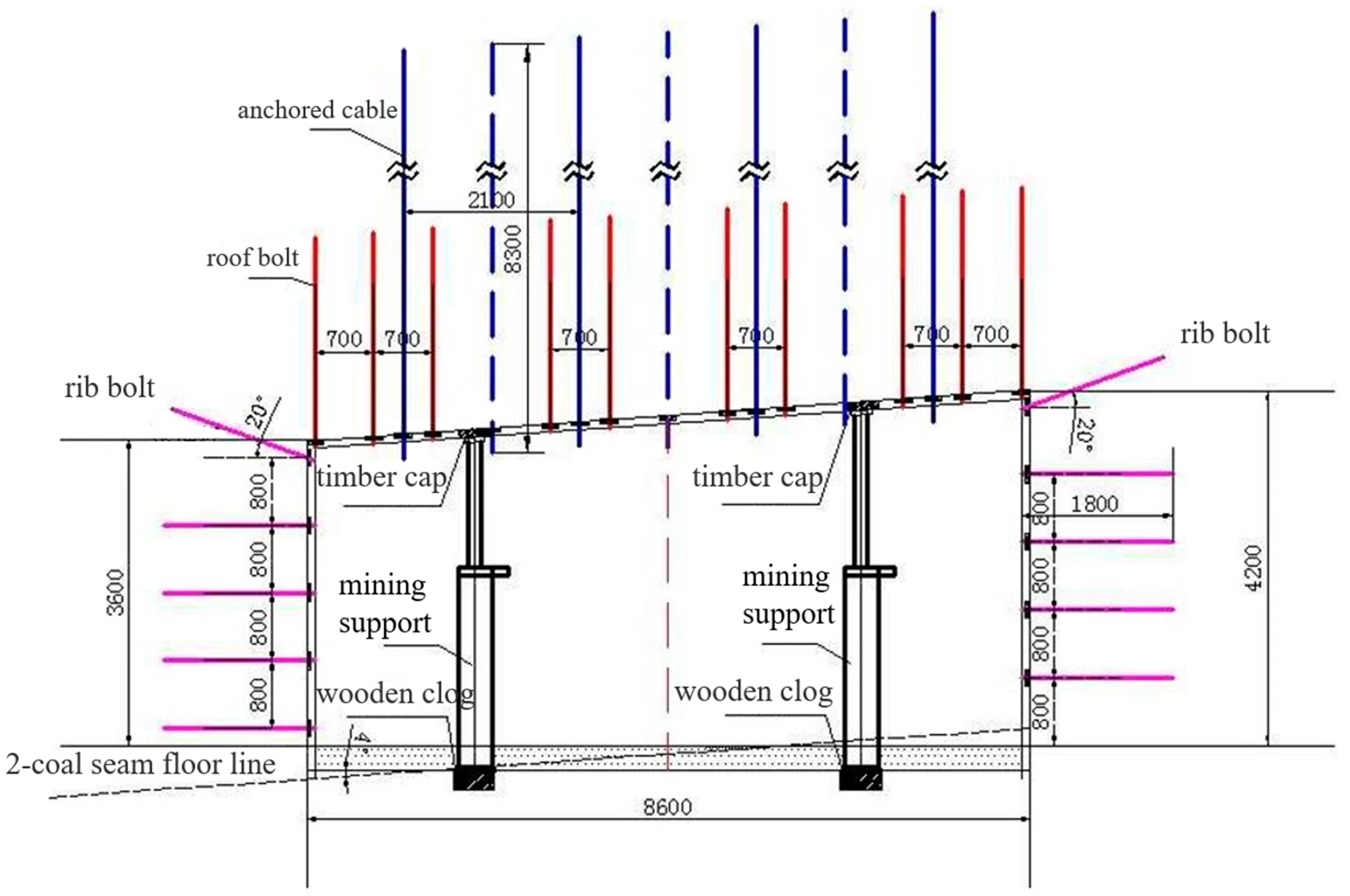
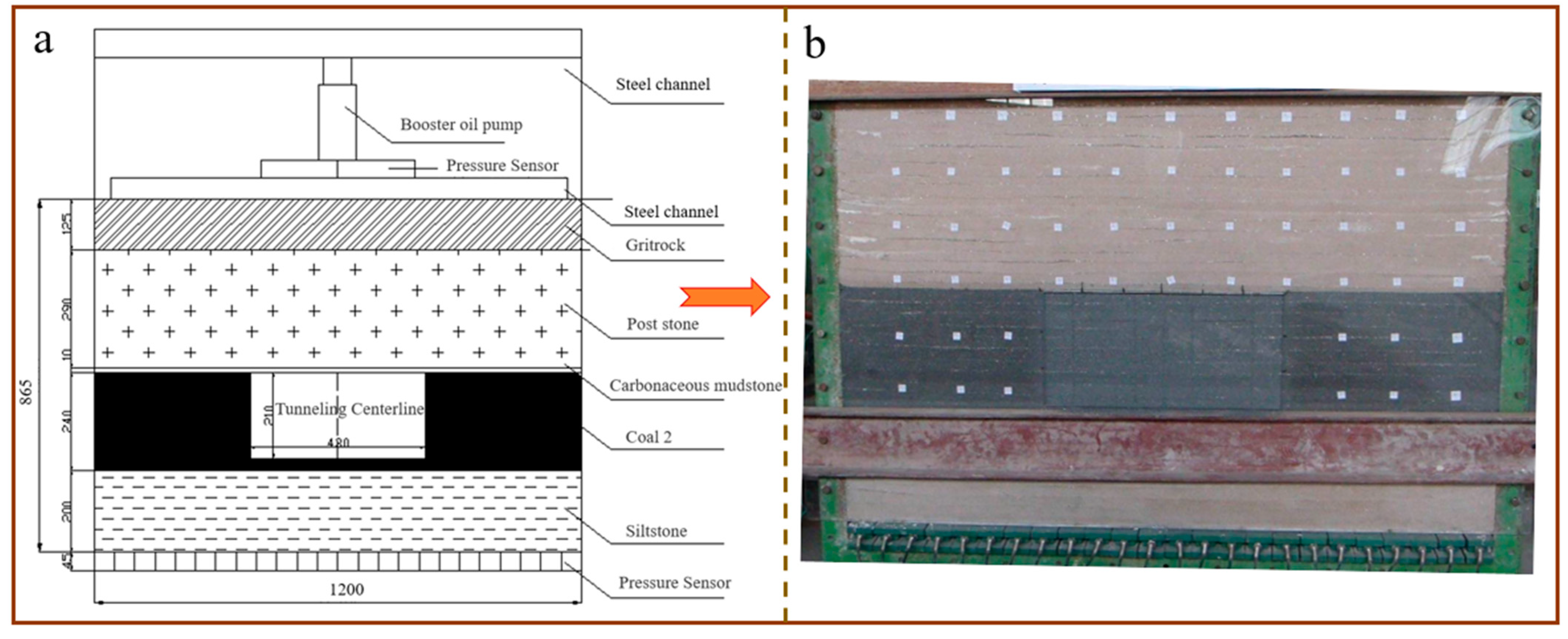
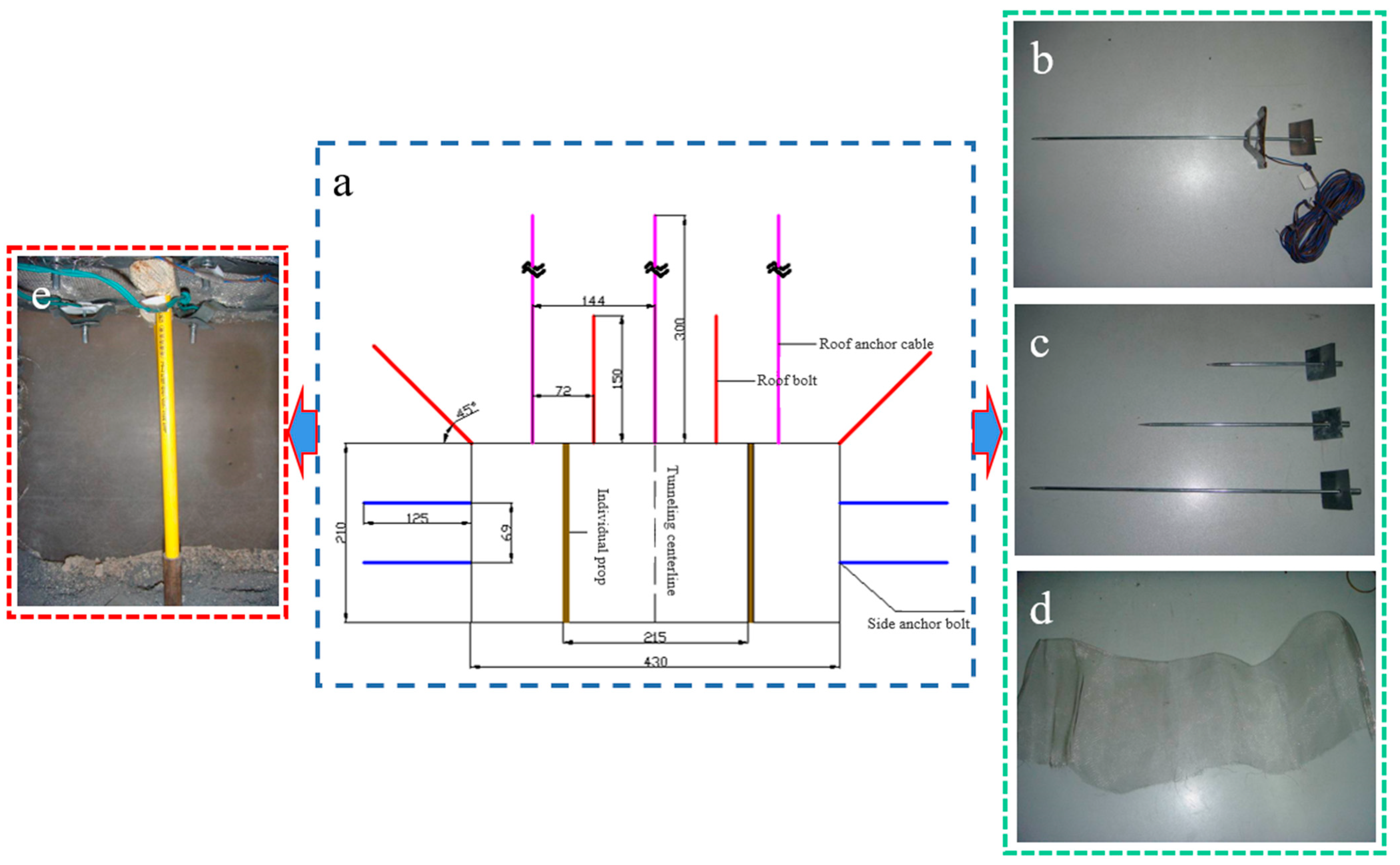
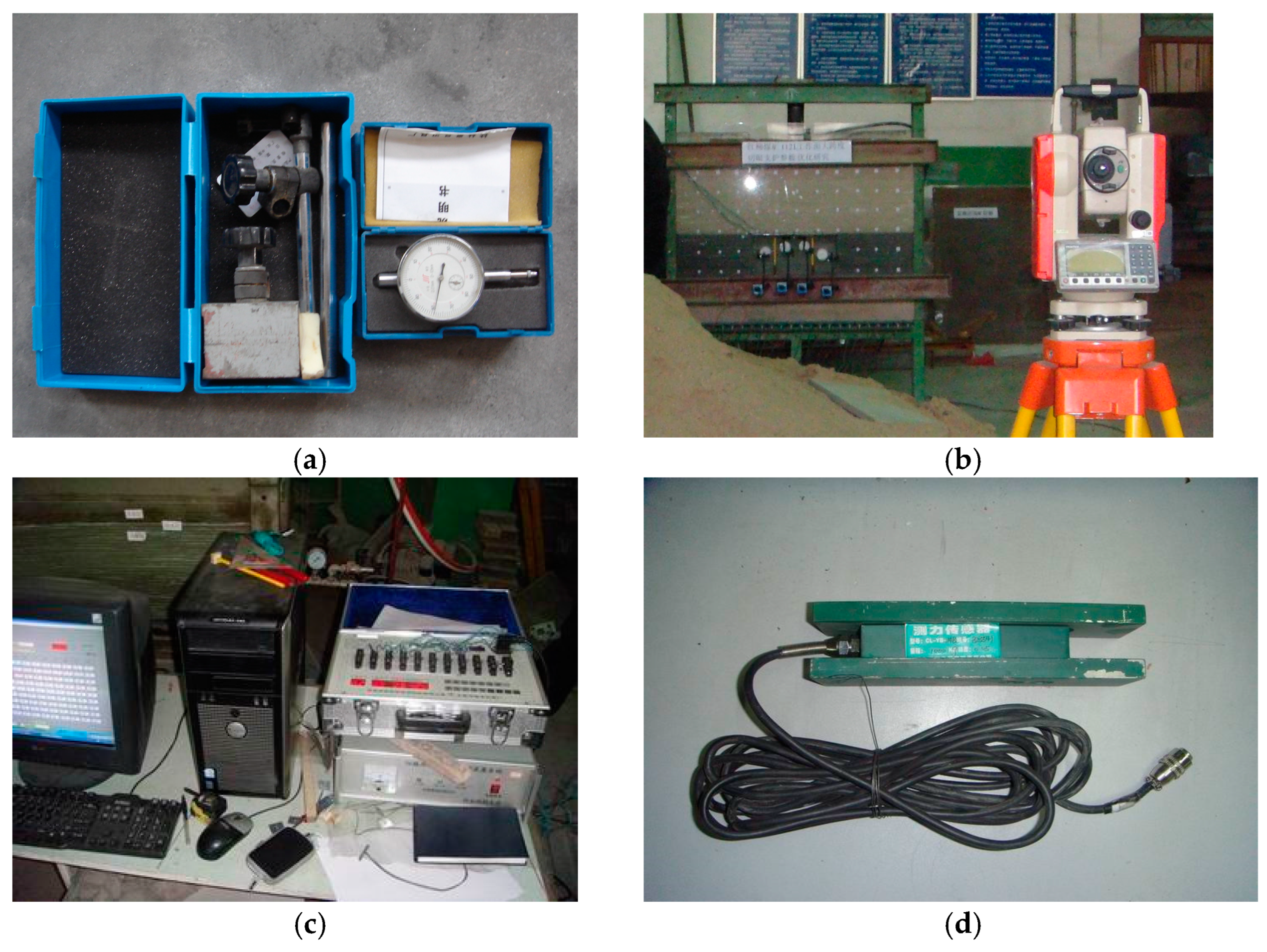
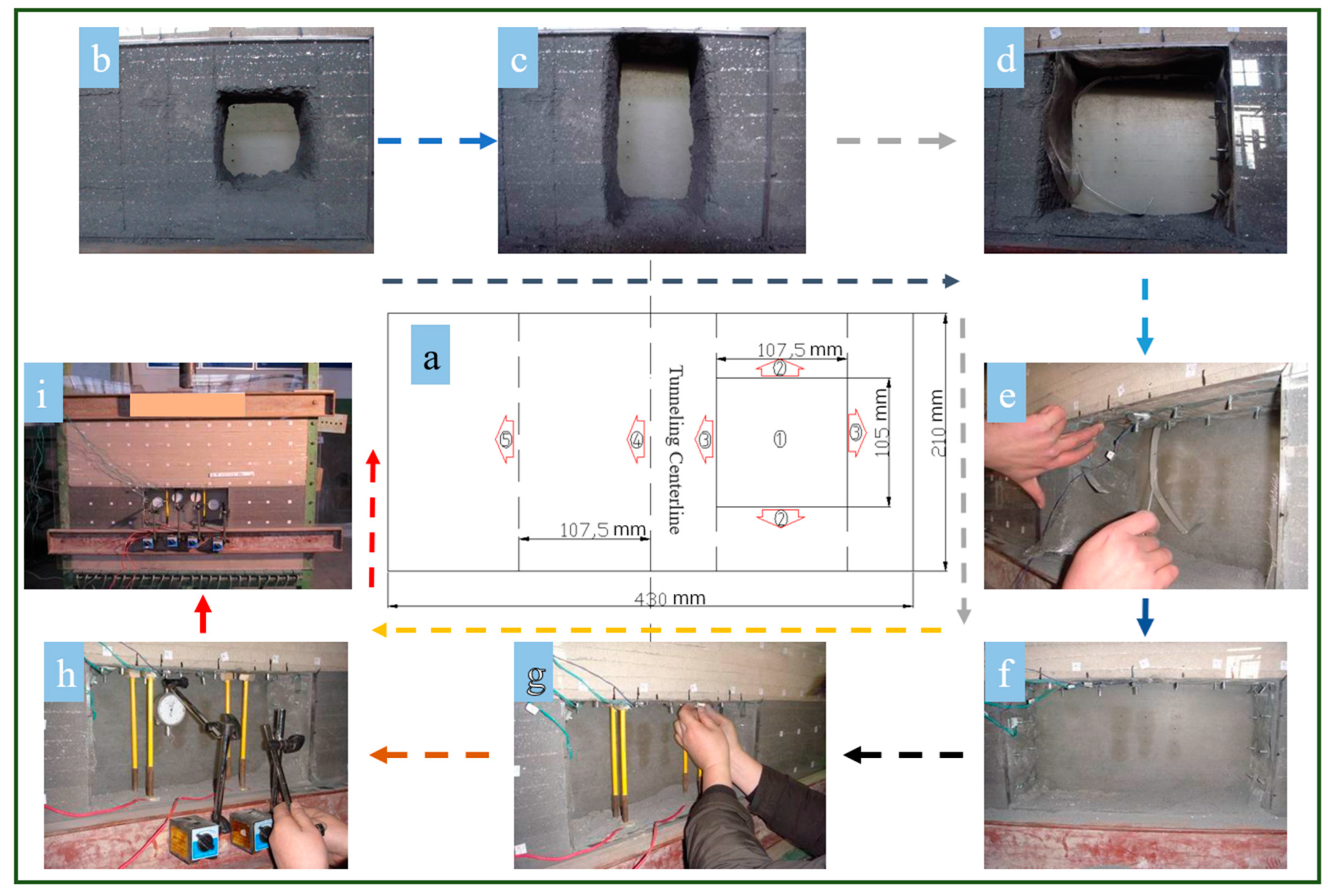

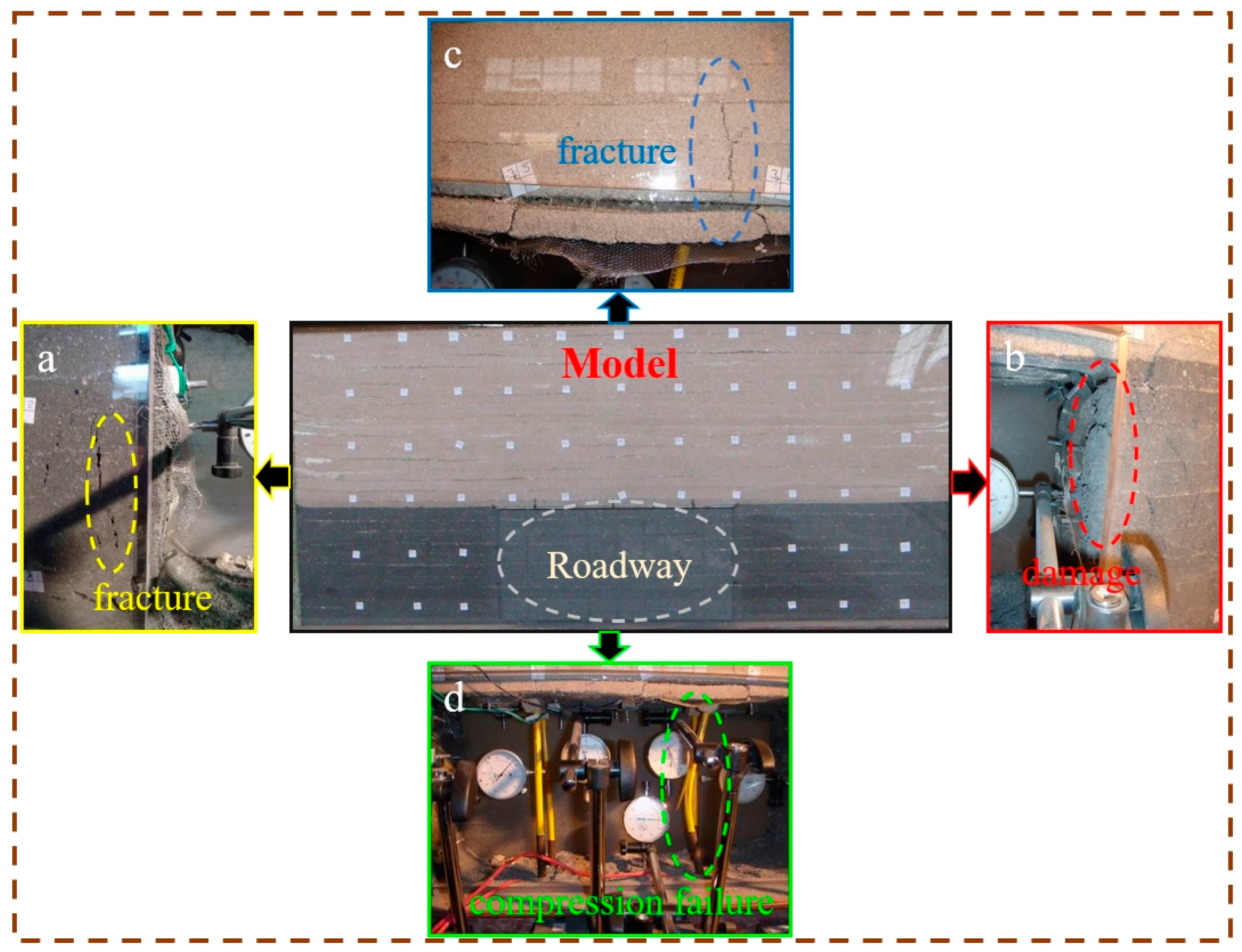
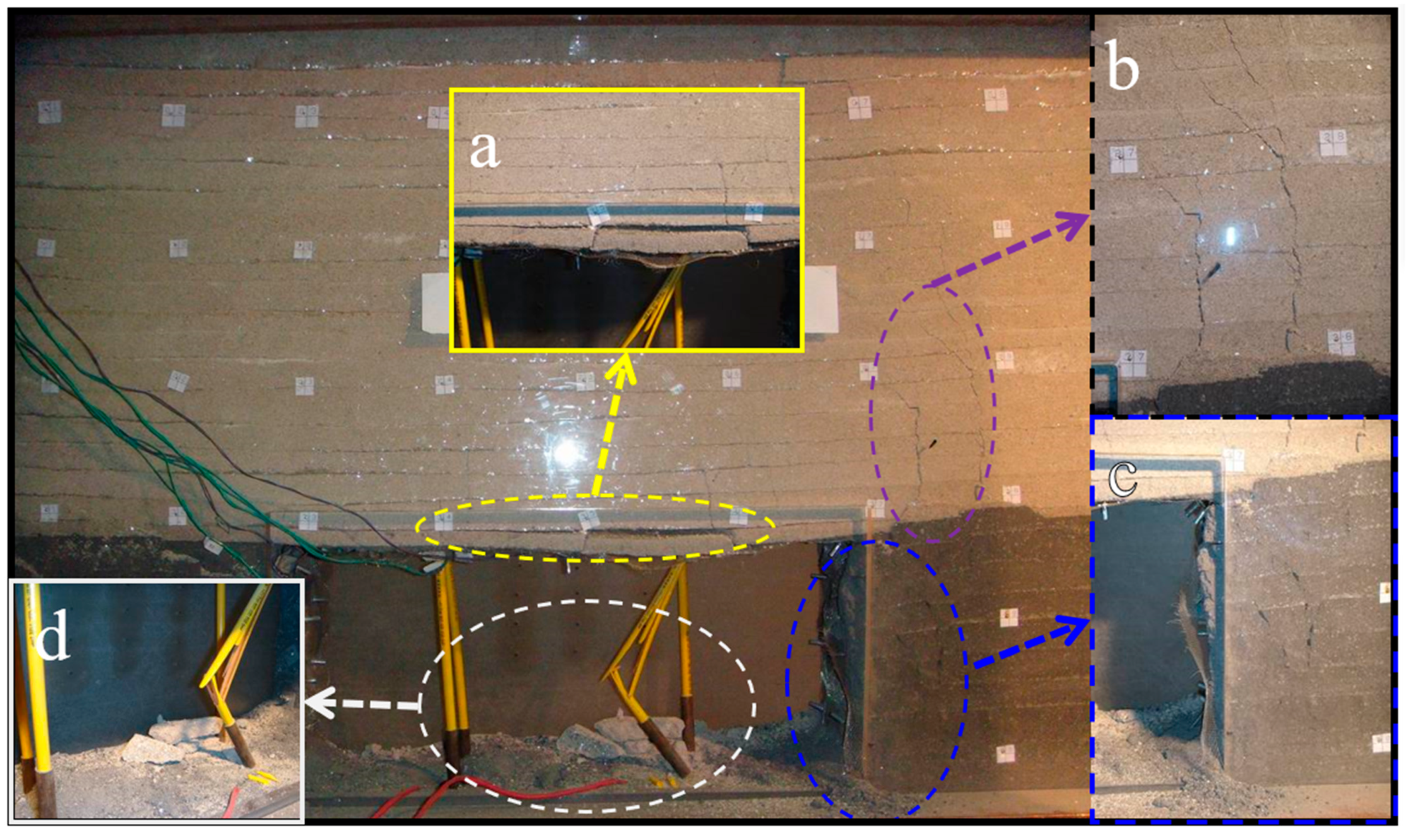
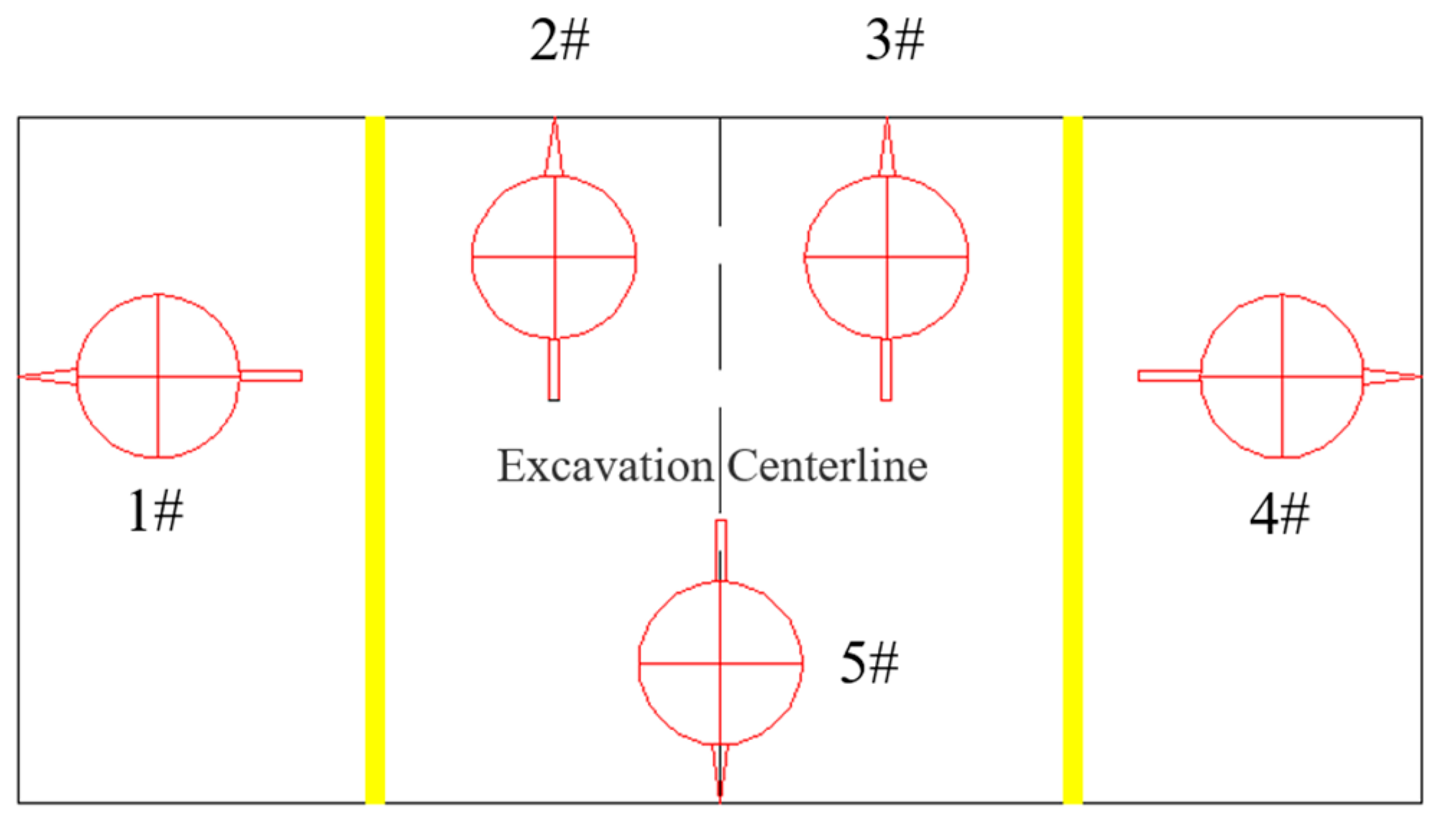
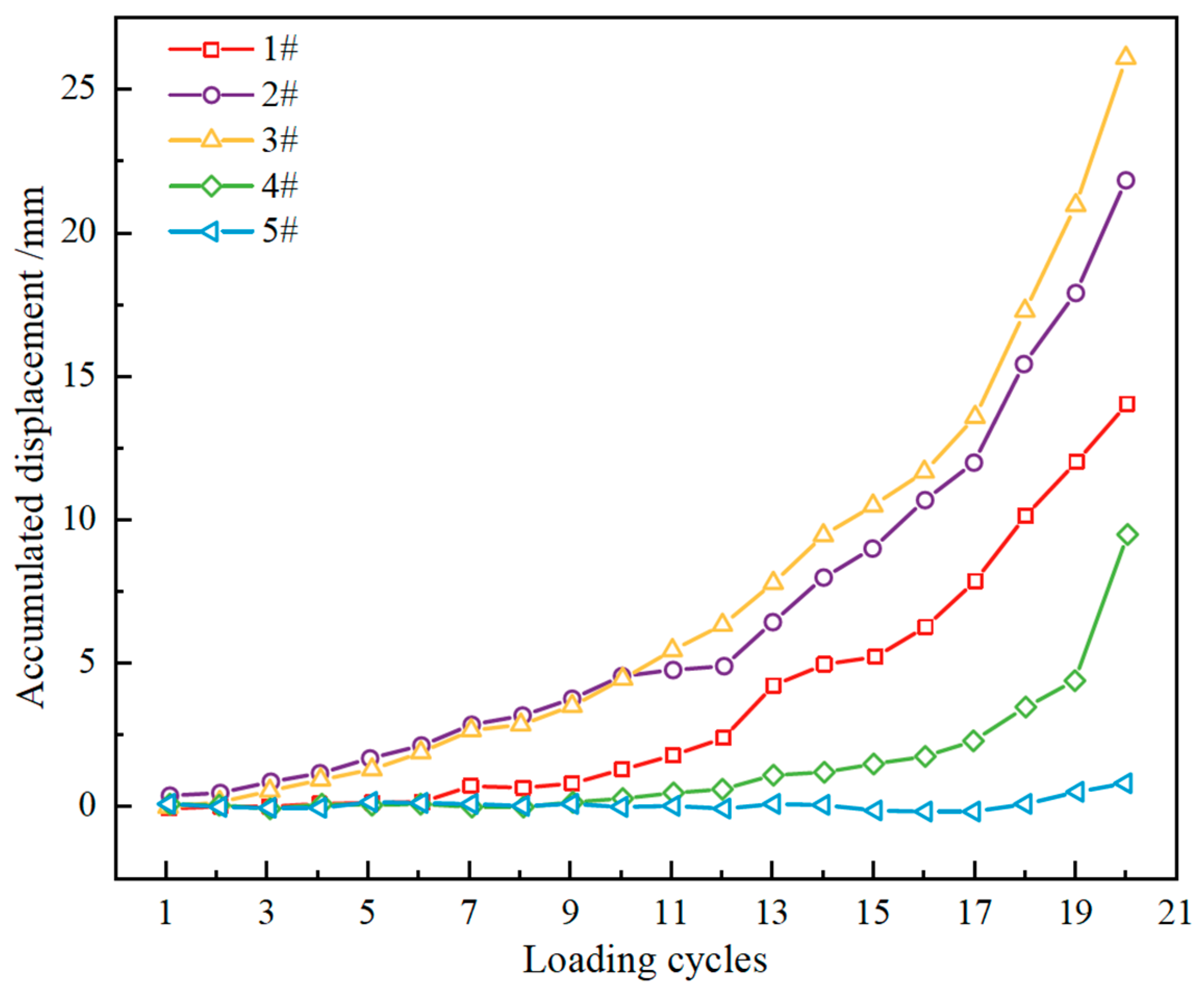



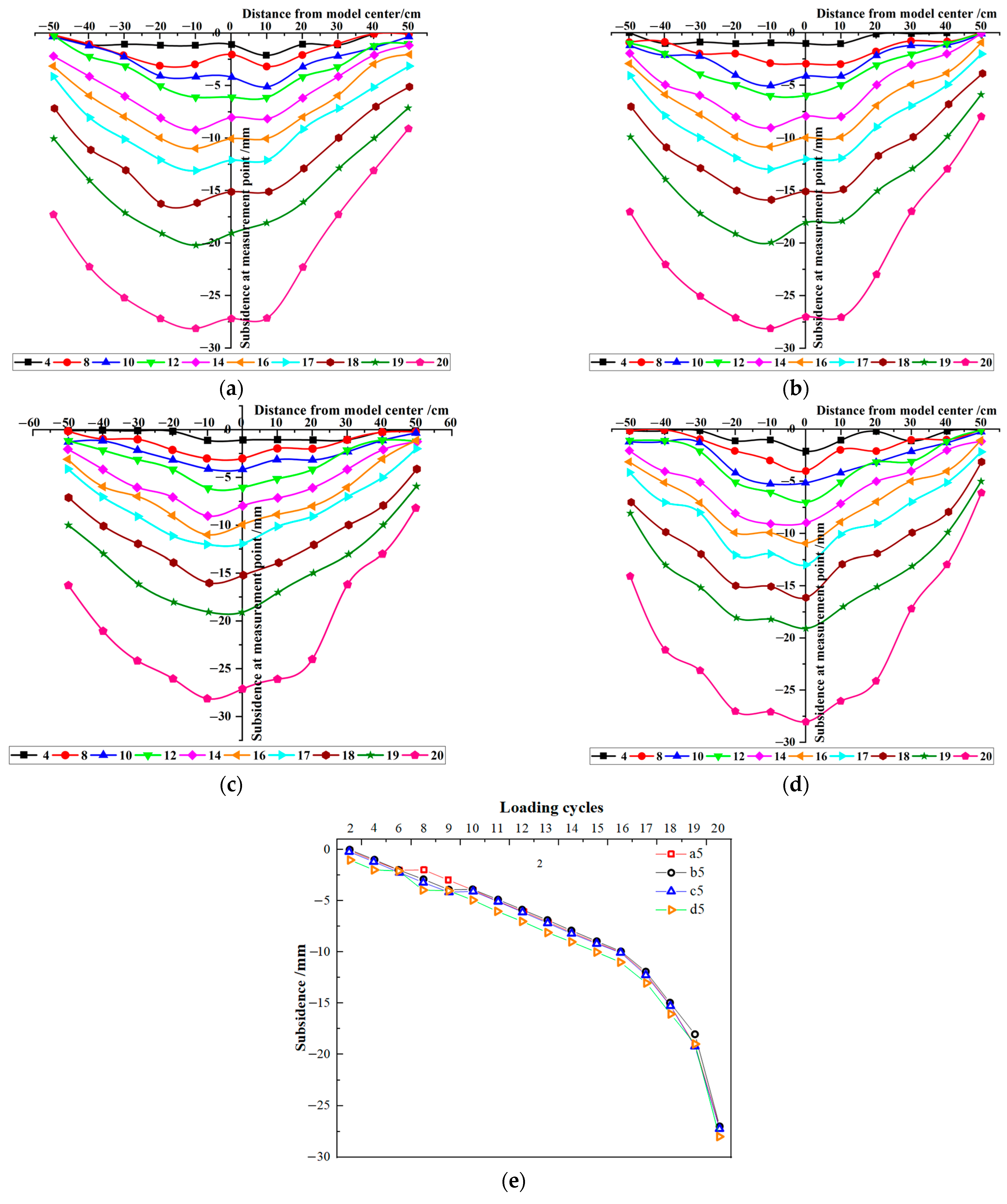
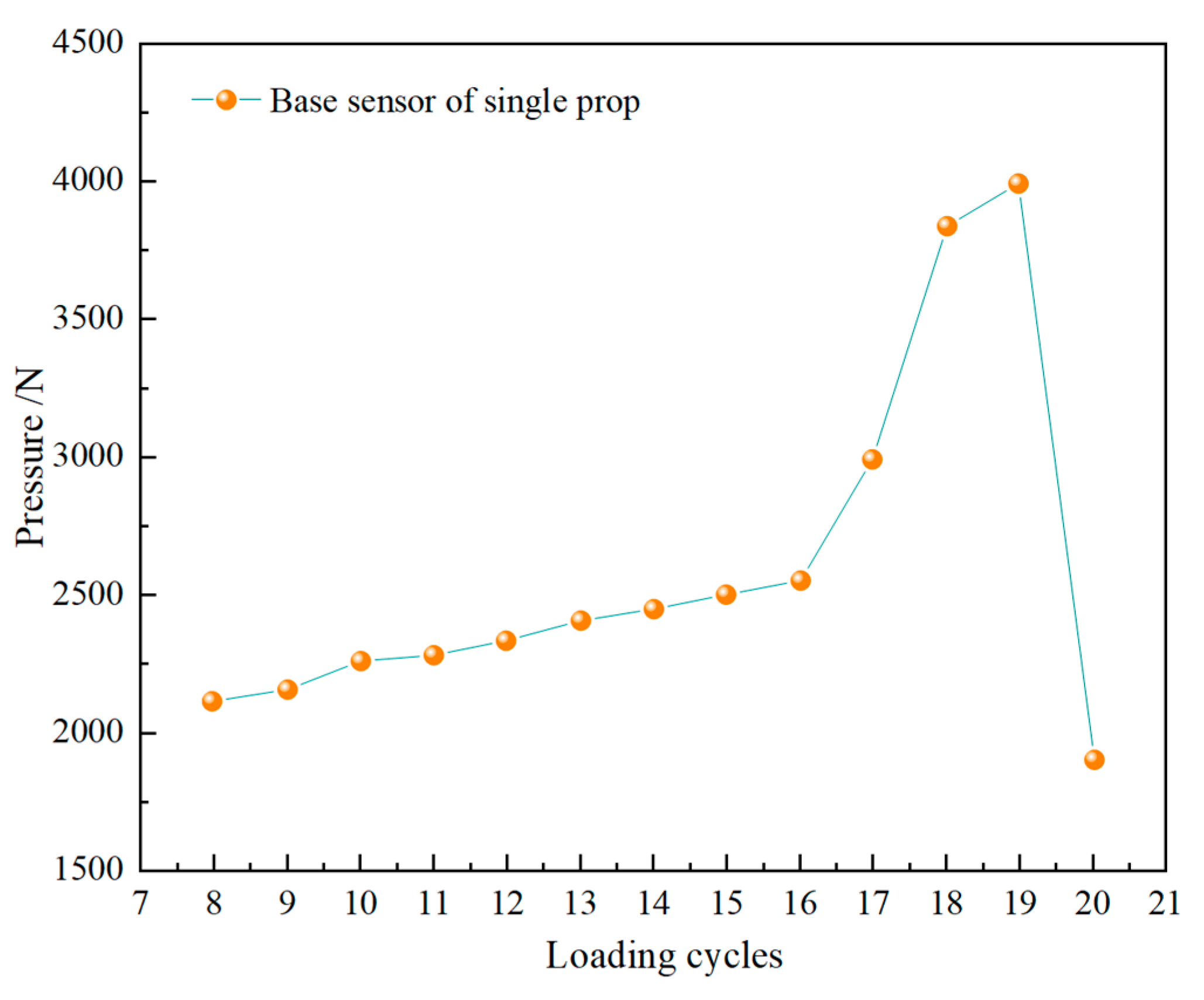
| Number | Rock Type | Stratum Thickness/m | Model Thickness/cm | Proportion Number | River Sand, Gypsum, talc/kg | Layer Thickness/cm | Number of Layers |
|---|---|---|---|---|---|---|---|
| 1 | Coarse sandstone | 2.5 | 12.5 | 728 | 4.032:0.115:0.461 | 2 | 7 |
| 2 | Fine sandstone | 5.8 | 29 | 746 | 4.032:0.230:0.346 | 2 | 15 |
| 2 | Carbonaceous mudstone | 0.2 | 1 | 837 | 2.048:0.077:0.179 | 1 | 1 |
| 3 | No. 2 Coal seam | 4.8 | 24 | 4.608 | 2 | 12 | |
| 4 | Siltstone | 4.0 | 20 | 737 | 4.032:0.173:0.403 | 2 | 10 |
| Number | Equipment | Function |
|---|---|---|
| 1 | High-precision dial gauge | Monitoring the movement and deformation of surrounding rock in roadway |
| 2 | PENTAX R-322NX optical total station | In the model cut, 56 monitoring points are arranged in the overburden rock layers as well as on the left and right sides to describe the displacement changes of the surrounding rock |
| 3 | 108-channel pressure data acquisition system | Monitoring the stress distribution of the coal pillar in the opening cut |
| CL-YB-114B pressure sensor | ||
| 4 | CL-1M-10 static resistance strain gauge | Monitoring the force changes at the ends of strain gauge anchor rod (cable) |
| 5 | Circular pressure sensor | Monitoring the stress changes in the single support pillar |
| 108-channel pressure data acquisition system |
| 1# | 2# | 3# | 4# | 5# | |
|---|---|---|---|---|---|
| Initial readings | 2.619 | 3.031 | 1.068 | 0.902 | 5.778 |
| Final cumulative readings | 16.636 | 24.913 | 27.328 | 10.363 | 6.514 |
| Cumulative displacement | 14.017 | 21.882 | 26.260 | 9.461 | 0.736 |
| Sensor number | 5 | 8 | 9 | 13 | 16 | 17 | 20 |
| Distance from centerline/cm | 1.12 | 0.693 | 0.663 | −2.83 | −2.12 | −0.56 | 0.92 |
| Pressure variation/kPa | 184.16 | 50.23 | 33.01 | −7.771 | 18.28 | 37.57 | 176.52 |
Disclaimer/Publisher’s Note: The statements, opinions and data contained in all publications are solely those of the individual author(s) and contributor(s) and not of MDPI and/or the editor(s). MDPI and/or the editor(s) disclaim responsibility for any injury to people or property resulting from any ideas, methods, instructions or products referred to in the content. |
© 2025 by the authors. Licensee MDPI, Basel, Switzerland. This article is an open access article distributed under the terms and conditions of the Creative Commons Attribution (CC BY) license (https://creativecommons.org/licenses/by/4.0/).
Share and Cite
Qu, Y.; Xu, M.; Hou, Y.; Li, C.; Chen, Y.; Chen, H.; Yuan, Q.; Zhang, M. Optimization of Support Parameters for Large-Section Open-Cut Roadways in Fully Mechanized Mining with Large Mining Height. Appl. Sci. 2025, 15, 4125. https://doi.org/10.3390/app15084125
Qu Y, Xu M, Hou Y, Li C, Chen Y, Chen H, Yuan Q, Zhang M. Optimization of Support Parameters for Large-Section Open-Cut Roadways in Fully Mechanized Mining with Large Mining Height. Applied Sciences. 2025; 15(8):4125. https://doi.org/10.3390/app15084125
Chicago/Turabian StyleQu, Yinghao, Meijing Xu, Yabin Hou, Chao Li, Yu Chen, Hanxin Chen, Qiang Yuan, and Mingtian Zhang. 2025. "Optimization of Support Parameters for Large-Section Open-Cut Roadways in Fully Mechanized Mining with Large Mining Height" Applied Sciences 15, no. 8: 4125. https://doi.org/10.3390/app15084125
APA StyleQu, Y., Xu, M., Hou, Y., Li, C., Chen, Y., Chen, H., Yuan, Q., & Zhang, M. (2025). Optimization of Support Parameters for Large-Section Open-Cut Roadways in Fully Mechanized Mining with Large Mining Height. Applied Sciences, 15(8), 4125. https://doi.org/10.3390/app15084125







